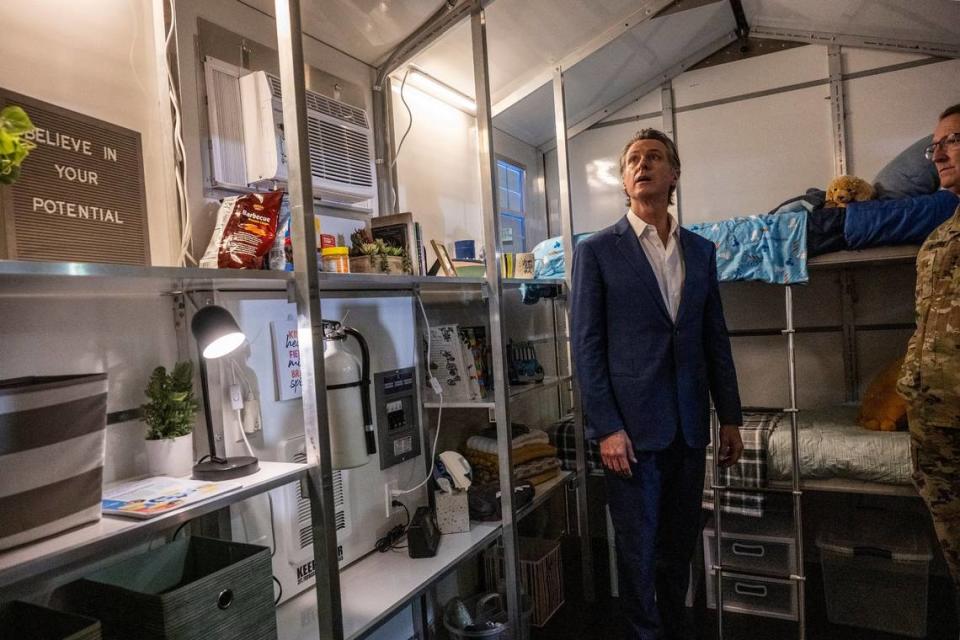California lawmakers want to overhaul homeless spending. But Newsom opposes long-term funding
- Oops!Something went wrong.Please try again later.
California devotes billions of dollars annually to curbing its homelessness crisis. But lawmakers want to overhaul the way the state distributes its money, saying the current system is ineffective and in need of more predictability.
Gov. Gavin Newsom, facing a budget deficit of at least $22.5 billion, has called for more accountability from communities for how they spend the money. At his January budget presentation, Newsom said lawmakers were “lighting (him) up” to carry bills that make continued funding contingent on reductions in homelessness.
At least two legislators are working on such measures. And budget bill language shows Newsom wants to tie eligibility for homelessness funding to local plans for meeting long-term housing needs.
But his administration has been loathe to commit to multi-year investments, which local advocates and leaders say are needed to achieve the results the governor wants.
“If it’s a California value that it’s unacceptable that there are 171,000 individuals who are homeless, then it should also be a California value to create a system to address that and to fund it,” said Graham Knaus, executive director of the California State Association of Counties.

Newsom homeless spending
California’s Homeless Housing, Assistance and Prevention Program (HHAP) grants have provided local governments with nearly $3 billion over four rounds of funding since 2019 for services, shelter and housing. The governor’s 2023-2024 budget provides another $1 billion for a fifth round.
Despite the heavy investment, California’s unhoused population has continued to grow. The state added 10,000 more homeless residents from 2020 to 2022, reaching a total of 171,521 people, according to the U.S. Department of Housing and Urban Development.
Newsom and lawmakers, unhappy with the lack of progress, have added more conditions to the money.
The first two rounds of funding had few strings attached. But rounds three and four included requirements to create local homelessness action plans with specific outcome goals. Ahead of round three funding in November, Newsom temporarily froze the money, saying the submitted goals were not ambitious enough.

Homelessness accountability framework
This budget cycle, Newsom and legislators are planning to be more specific about their expectations for HHAP round five funding.
The governor’s administration has submitted a bill that suggests tying the money for cities and counties to submission of acceptable long-term plans for housing, known as “housing elements.”
Local governments are required to submit such plans to the state every five to eight years showing how they will produce enough units as their communities grow over time. Cities and counties with plans that don’t comply with state standards are not eligible to receive certain funding.
“If a community is not meeting its basic requirements on housing, it really calls into question their ability to make a positive impact on homelessness, because those two things are so deeply interlinked,” said Jason Elliott, Newsom’s deputy chief of staff.
Assemblywoman Luz Rivas, D-San Fernando Valley, and Assemblyman Phil Ting, D-San Francisco, plan to promote their own accountability measures, which could eventually be consolidated with some of Newsom’s proposals.
Rivas’s bill would redistribute money from communities and organizations not meeting goals and give it to other, more successful groups in the same region.
Ting has not yet proposed specific language for his bill, but he said he wants to figure out “what metrics do we put in place so everyone maximizes the money, and they maximize their goals.”
“I think what we’re trying to do is drill down and be a little bit more specific about what we’re trying to get after, from HHAP but also homeless funding, in general,” Ting said. “The bottom line is, people care about really two things. They care about people moving into permanent housing, and they care about people getting off the streets.”

Advocates push for ongoing funding
But Knaus and homeless advocates backing Rivas’s bill continue to push the state to extend its HHAP commitment. Right now, Newsom’s administration has not announced plans for allocations beyond the fifth round.
“I think the governor has been very clear that new multi-billion dollar ongoing funding proposals are not going to be able to be accommodated in this budget,” Elliott said.
In late February, Rivas wrote to Ting, the Assembly Budget Chair, and Los Angeles Assemblywoman Wendy Carrillo, who chairs Budget Subcommittee 4 on State Administration, asking for $2 billion in ongoing funding
“The state is currently allocating billions to programs that may not be effectively reducing our homelessness population and without an aggressive investment and restructuring of our state and local homelessness response efforts, we will likely continue to see our homeless rates increase,” Rivas wrote.
Alex Visotzky, senior California policy fellow at the National Alliance to End Homelessness, said the state needs to approach homeless services like it does education.
“Service providers need that kind of predictability of stability in order to plan and scale up and hire and consistently deliver strong outcomes,” Visotzky said. “We would never ask or expect our schools to be able to effectively educate our kids if they weren’t sure if they were going to be getting funding from Sacramento next year.”
Knaus and the California State Association of Counties created a plan called AT HOME, which calls for the state to better define city, county and state roles for implementing homeless policy.
He said without a more clear framework and ongoing funding, his organization can’t support plans like Newsom’s proposal to connect housing elements and homelessness dollars.
“There isn’t clear authority,” Knaus said. “There isn’t clear responsibility. There isn’t sufficient flexibility, and it’s unclear whether there’s sufficient funding to meet the expectations.”

